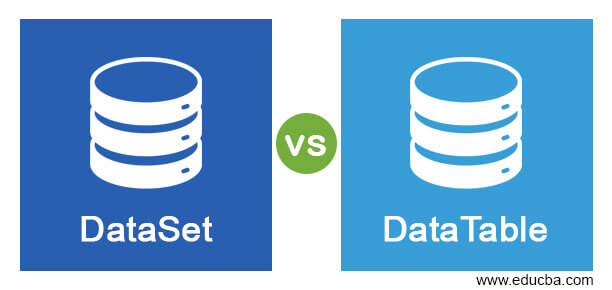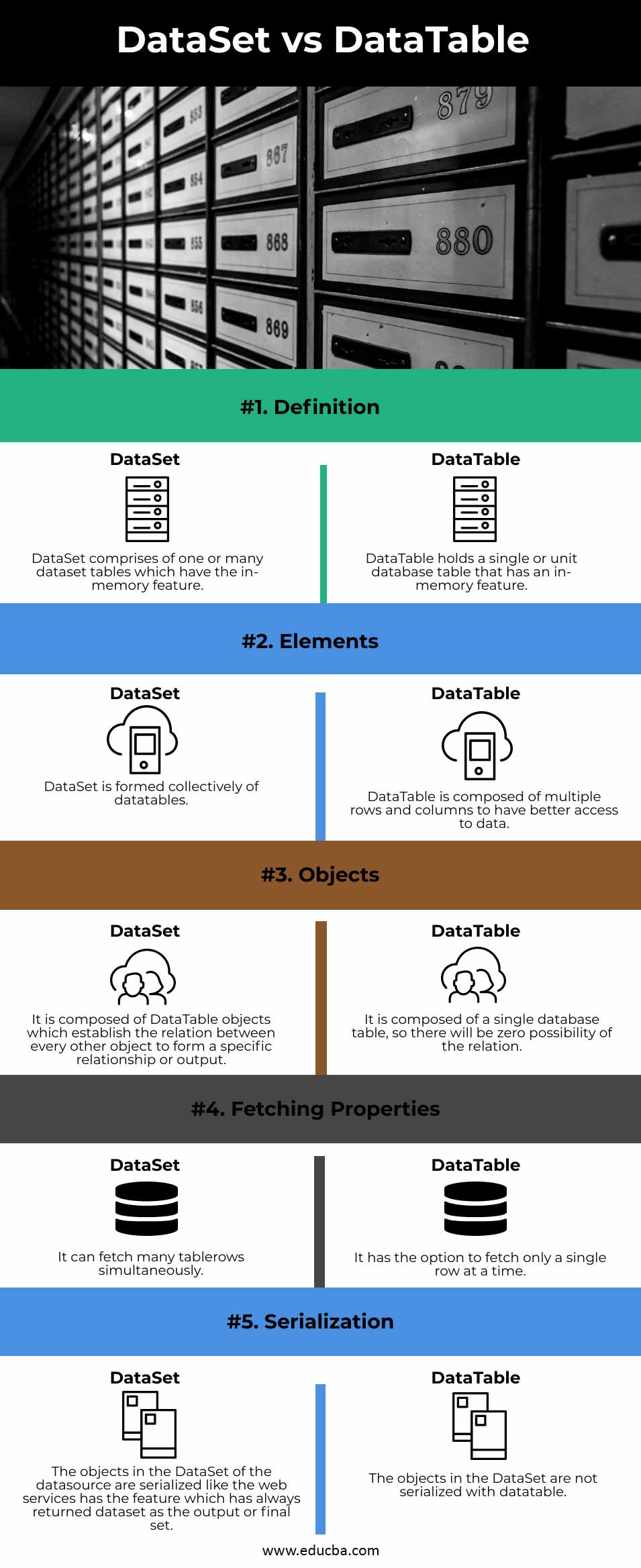Difference between DataSet vs DataTable
The following article provides an outline for DataSet vs DataTable. Dataset is comprised of relationships, tables, and constraints, and the objects in the dataset are implied to represent the tables present in the dataset. The dataset is implied to avoid direct interaction with the database by meek SQL statements. It is used to behave like a cheap local copy of the required data as it doesn’t need any maximum latency to connect with the expensive database. Whereas the datatable denotes the in-memory relational data present in one table. Here the data is local and depends on the application in which it’s situated but can be multiplied from a data source like an SQL server.
Dataset is a representation of in-memory elements of a structured database that has a pool of datatables. The unique dataset can fetch any number of tablerows at a stretch in a single time. In the dataset, the objects in datatable can be associated with others with the help of datarelation objects. By implying the object of ForeignKeyConstraint and UniqueConstraint, the data integrity is enforced in the dataset. The datasource contains a serialized dataset and that is the reason behind the web services being able to return the dataset as a final output but doesn’t return datatable.
A datatable follows the process of in-memory representation on a table of a single database which is comprised of rows and columns. Here, only one table row can be fetched by datatable at a single stretch. The provision of datatable and objects of datarelation is null. As a datatable is a single unit in the database table it doesn’t possess any datarelation object inside it. The enforcement of data integrity is dynamic in datatable as there has zero uniqueconstraint key and the multiple objects of ForeignKeyConstraint. The datatable cannot be sequential to the datasource.
Head to Head Comparison Between DataSet vs DataTable (Infographics)
Below are the top 5 differences between DataSet vs DataTable:
Key Difference between DataSet vs DataTable
Let us discuss some of the major key differences between DataSet vs DataTable:
The important differences between dataset and datatable can be its working, structure application, integrity, properties, definition, objects.
- Working of dataset and datatable: The dataset has a class in-built in it which is called a typed dataset. It gets all the events, processes, and properties of a dataset. A typed dataset offers strong and stable information on processes, events and properties. So it insists that the user can access the columns and tables by the unique name, apart from using the methods based on collection values. It has enhanced the reliability of code, where the dataset enables the visual studio, code editor in .NET to automate the complete lines as per the type. The strong dataset offers the contact to values to get a precise type at a compiled time. By using a strong dataset, the mismatch errors are captured and the code is compiled reasonably than the run time. The datatable is a member of system.data located within the framework of the .NET class library. The user can create an independent datatable or become a member of the dataset and objects in datatable to be used to connect with other objects in .NET framework includes the data view. The user can work on the collection of tables in the dataset via the property of the table in the dataset object.
- Structure: The schema of the table is represented by constraints and columns and also explains the datacolumn and datatable as well as in UniqueCostraint and ForeignKeyConstraint. The column in the table can be linked to a data source, which has computed values from the derived expression, automatically increase the value or holds the value of primary keys. The datatable has rows to hold and arrange the data. The class representation of datarow contains the original data in the table. The user can make use of datarow and the methods and properties to evaluate, retrieve, and compute the data in the table. The user can manage and alter the data present in the row which maintains the original and current state. The user can create a child-parent relationship between the tables and uses one or multiple associated columns or rows in the table. The developed datatable and its relationship with the objects by using the datarelation. It can be used to return the associated child or parent rows of a concerned row or column.
- Applications: The dataset is used to manipulate the remote and update the database with the new data. Hence it enables the discontinuity between the working with data. It enhances the performance by limiting the number of a database linked with data manipulations. In the datatable, the user can load a single database table into the memory of the datatable. If the user wants to get the information from a single table on the database, then he opted for the best choice. When the dataset is the other issue, the datarelation can explain the association between datatable by using the foreign key which is placed between the tables in the database. The dataset themselves doesn’t hold any data and datatable holds the dataset where the data is placed.
Comparison Table of DataSet vs DataTable
Let’s discuss the top comparisons between DataSet vs DataTable
| Features | DataSet | DataTable |
| Definition | DataSet comprises one or many dataset tables which have the in-memory feature. | DataTable holds a single or unit database table that has an in-memory feature. |
| Elements | DataSet is formed collectively of datatables. | DataTable is composed of multiple rows and columns to have better access to data. |
| Objects | It is composed of DataTable objects which establish the relation between every other object to form a specific relationship or output. | It is composed of a single database table, so there will be zero possibility of the relation. |
| Fetching Properties | It can fetch many tablerows simultaneously. | It has the option to fetch only a single row at a time. |
| Serialization | The objects in the DataSet of the datasource are serialized like the web services has the feature which has always returned dataset as the output or final set. | The objects in the DataSet are not serialized with datatable. |
Conclusion
Hence, these are major notes of the DataSet and DataTable. It can be used accordingly to obtain the maximum performance in the server. The process and activities are more time and space-consuming which is cost-effective.
Recommended Articles
This is a guide to DataSet vs DataTable. Here we discuss key differences with infographics and comparison table respectively. You may also have a look at the following articles to learn more –




